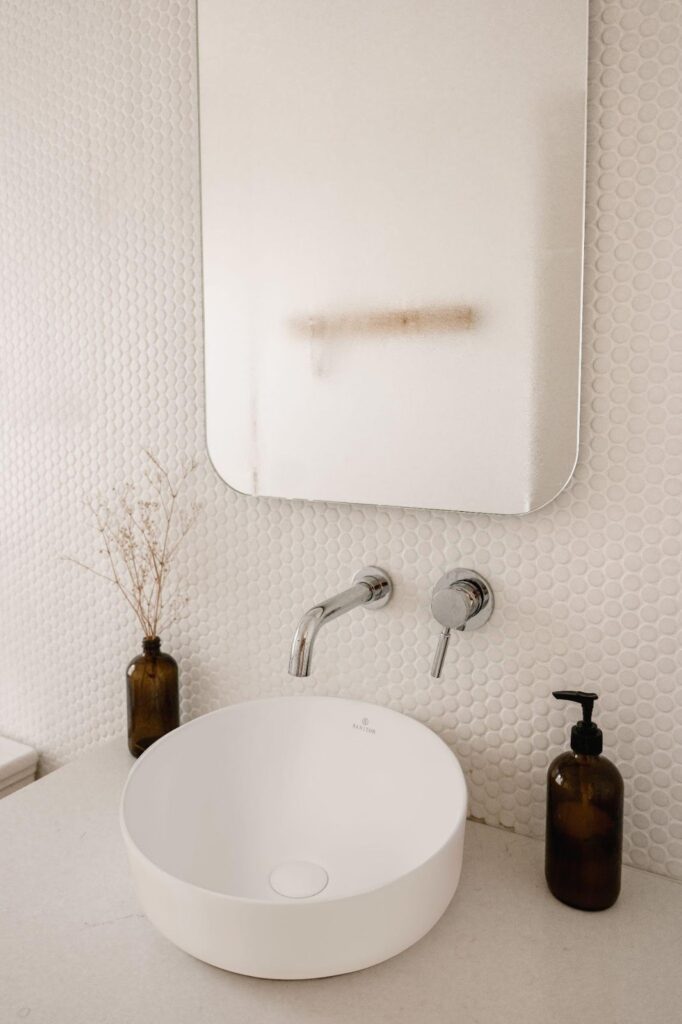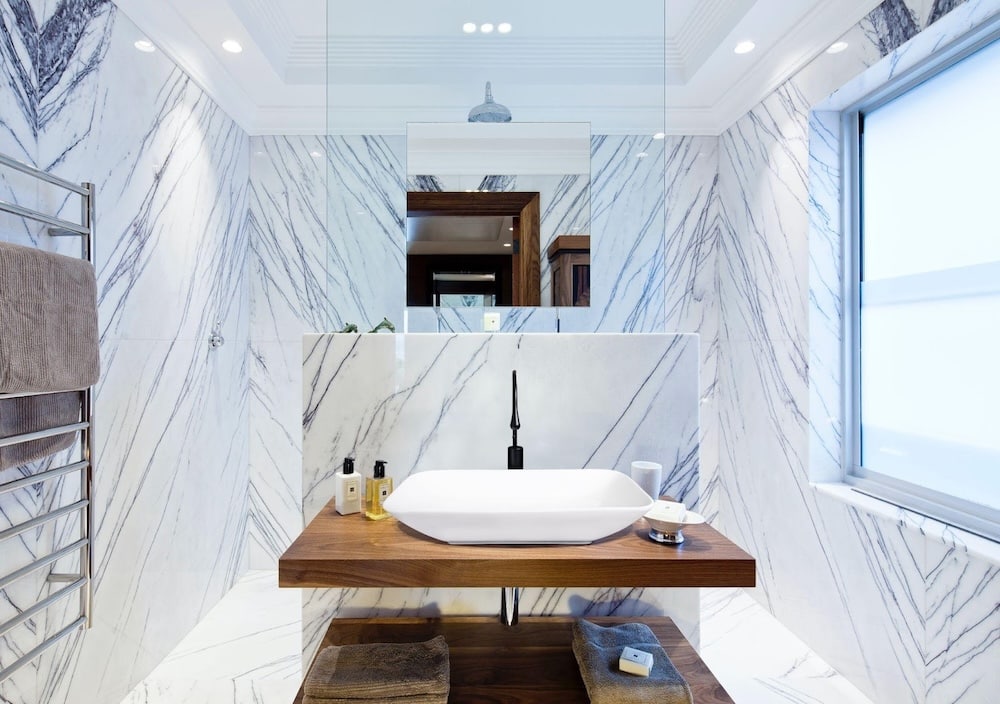When it comes to bathroom and kitchen fixtures, the terms “sink” and “basin” are often used interchangeably, but they aren’t exactly the same. While both serve the purpose of holding water for washing, the main difference between a sink and a basin is that sinks are deeper for heavy-duty use, while basins are shallower and suited for light hygiene tasks.
Defining the Modern Sink
A modern sink is a bowl-shaped plumbing fixture permanently installed and integrated into your home’s plumbing system, equipped with both a drain and a dedicated water supply, typically featuring its own taps or faucet. It serves the functional purpose of delivering and disposing of water for everyday washing tasks.
Beyond functionality, modern sinks are crafted from a wide array of materials. From stainless steel and ceramic to granite, copper, glass, and even wood, there are options that suit various design styles.
Optimal Locations for Sink Installations
When it comes to optimal locations for sink installations, the kitchen and laundry room are the most common and logical choices.
In the kitchen, for instance, sinks, often extending between 22 and 30 inches in length and 7 to 10 inches, provide ample space for washing, rinsing, and food prep.
In laundry rooms, sinks tend to be even larger: typical sizes span 20 to 23 inches in length and 17 to 20 inches in width, with capacities ranging from 30 to 70 litres. Their ample space makes them ideal for tasks like washing delicate garments or rinsing stained items before machine washing.
Understanding the Concept of a Basin
A basin today is more than just a simple bowl for washing—it has evolved into a permanent bathroom or kitchen fixture that combines hygiene with style. Connected to both the water supply and drainage system, it supports essential daily tasks such as handwashing, brushing teeth, and cleaning, while also contributing to the overall interior design.
Modern basins are available in a variety of styles, including countertop, wall-hung, pedestal, and under-counter options, and are crafted from materials like ceramic, glass, or stone. Many also incorporate hygienic features and sleek aesthetics, reflecting the growing emphasis on convenience, sustainability, and lifestyle in contemporary living.
Primary Placements for Wash Basins
Basins are most commonly installed in washroom environments such as bathrooms or powder rooms, where their design truly shines. This is due to the difference in depth and functionality compared to sinks, as basins are shallower and better suited for personal hygiene activities like washing hands.
This design delivers sufficient functionality and adds practicality to bathroom spaces, balancing space efficiency with aesthetic appeal. However, because of their shallower bowls, basins are not well-suited for kitchen or laundry applications, where sinks are required to handle heavy-duty tasks like dishwashing or soaking large items.
Are the Terms “Basin” and “Sink” Truly the Same?
While the terms “basin” and “sink” are often used interchangeably in everyday conversation, they are not entirely the same. The distinction lies primarily in their design, depth, and intended use.
| Feature | Sink | Basin |
| Definition | A stationary bowl with a tap and drain, typically deeper for handling heavy-duty tasks. | A shallow dish or open vessel with sloping or curved edges, designed for lighter tasks like washing hands or face. |
| Common Usage | Found in kitchens, bathrooms, and utility areas, used for dishwashing, cleaning, and other heavy-duty tasks. | Commonly found in bathrooms or powder rooms, used for personal hygiene activities. |
| Composition | Made from materials like glass, granite, quartz, fireclay, porcelain, composite, stainless steel, or copper. | Often made from ceramic, steel, or acrylic. |
| Shape | Available in many designs such as corner sinks, double-basin sinks, rectangular, or custom combinations. | Common shapes are rectangular, circular, oblong and square. |
| Water stopper/drain | Yes | Yes |
| Tap compatibility | Most models come with pre-drilled holes for taps and other attachments. | Some basins are compatible with tap installation on the basin itself, while for others, wash basin taps are installed separately. |
The Etymology of “Sink” and “Wash Basin”
Exploring the origins of the word “basin” reveals that it entered Middle English around the 13th century, derived from the Old French bacin, which in turn traces back to Vulgar Latin baccīnum, meaning a water vessel, possibly of Gaulish origin. This lineage captures its evolution from a shallow liquid-holding vessel or dish, perfectly aligning with the contemporary idea of a basin as a wash bowl or shallow container.
On the other hand, the term “sink” has a notably different etymological path: it stems from the Old English verb sincan, meaning “to become submerged,” “subside,” or “go under,” itself emerging from Proto-Germanic senkwan and the Proto-Indo-European root sengw– “to sink”. The noun form, referring to a receptacle or basin for water disposal, originated in the early 15th century as a metaphorical and functional extension of the verb, denoting the fixture into which water sinks or drains.
Together, these etymologies illustrate how “basin” and “sink” may seem interchangeable in modern usage; their roots signify distinct concepts.
Practicality Check: Can You Swap Kitchen Sinks and Bathroom Basins?
When considering whether you can swap a kitchen sink for a bathroom basin, a practicality check reveals that it’s typically not advisable, largely due to their contrasting design intentions and functional requirements.
- Shallow wash basins fall short in kitchen settings. Bathroom basins generally have limited depth and capacity, often only accommodating a gallon or two of water. Using them for tasks like washing dishes or rinsing produce in the kitchen would likely lead to frequent splashes and messes.
- Conversely, kitchen sinks are impractically large for bathrooms. Their substantial depth and size might overwhelm the aesthetic and spatial layout of a typical washroom, where only minimal washing is needed.
- Bathroom tasks demand neither size nor storage. Activities like handwashing, tooth brushing, or face rinsing don’t necessitate large fixtures, making large kitchen sinks unnecessarily bulky and inefficient in such settings.
While the theoretical possibility of swapping exists, matching fixtures to their intended environments, deep, durable sinks for kitchens, and compact basins for bathrooms, remains the most effective and visually pleasing approach.
Why Are Saniton Wash Basins Your Top Choice?
Whether you’re redesigning a compact bathroom or specifying fixtures for a luxury development, our wash basins in Singapore are thoughtfully designed for those who want the perfect balance between form and function.
- Premium Durability: Crafted from high-quality materials to ensure long-lasting performance in homes and commercial spaces.
- Elegant, Modern Designs: Modern aesthetics that complement both minimalist and luxury bathroom interiors.
- Affordable Luxury: Comparable to international brands in quality and style, but at a more accessible price point.
- Tailored for Singaporean Bathrooms: Designed to suit compact spaces and local installation standards.
- Versatile Range: From compact, space-saving options to statement pieces for high-end projects.
- Sustainable & Comfortable: Thoughtfully designed to enhance user comfort while conserving water.
Explore Saniton’s Range of Wash Basin Designs
Below is an overview of our key wash basin types to help you choose the one that best meets your needs.
1. Wall-Mounted Basins
Wall-mounted basins are affixed directly to the wall, leaving the floor space below open. This not only saves valuable space but also creates a clean, contemporary aesthetic that’s easy to maintain. Their streamlined design makes them a popular choice in modern bathrooms seeking a minimalist look.
2. Undercounter Basins
Undercounter basins are installed beneath the counter or vanity, resulting in a seamless, modern look. This style maximises visual appeal and makes cleaning easier. Perfect for homeowners who value a sleek, minimalist aesthetic, these wash basins combine elegance with everyday practicality.
3. Above-Counter Basins
Above-counter basins are placed on top of a counter or vanity unit, serving as a functional fixture and a striking design element. They create a focal point in the bathroom while allowing for additional counter space around the wash basin for toiletries and accessories. Ideal for bathrooms with ample surface area, they bring a sense of luxury and sophistication to the space.
4. Semi-Recessed Basins
Semi-recessed wash basins are partially embedded into the countertop while projecting outward, making them an excellent choice for toilets or bathrooms with smaller countertop space. Because the basin extends from the front of the counter, it doesn’t require a deep vanity unit, making installation easier in compact bathrooms. This design saves floor space while still offering a reasonably sized bowl for comfortable use, a smart solution for maximising space without compromising on function or style.
Elevate Your Bathroom with Saniton Wash Basins

A well-selected wash basin not only fulfils its functional role but also elevates the visual appeal of your bathroom. With Saniton’s extensive range of designs, you can find the ideal fit for any style, size, or practical requirement. Purchasing a Saniton wash basin is simple and convenient; you can shop directly on Lazada or Shopee, or visit our showroom in Singapore.
Explore our collection of wash basins today and bring home the perfect one for your space.

